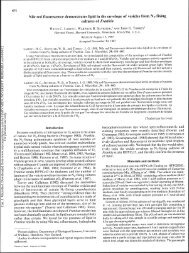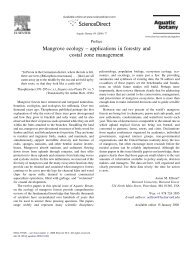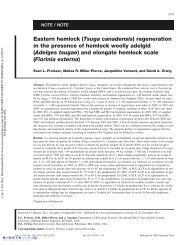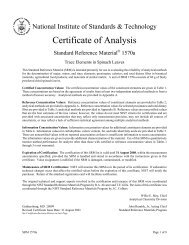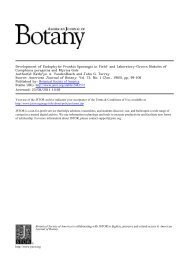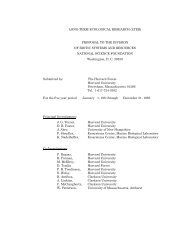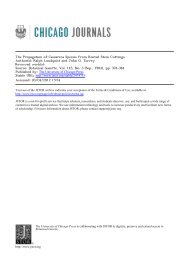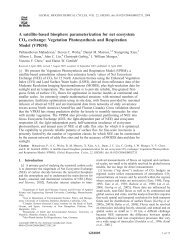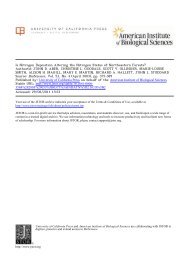Abstracts of Papers - Harvard Forest - Harvard University
Abstracts of Papers - Harvard Forest - Harvard University
Abstracts of Papers - Harvard Forest - Harvard University
Create successful ePaper yourself
Turn your PDF publications into a flip-book with our unique Google optimized e-Paper software.
its acentric position throughout later stages <strong>of</strong><br />
sporogenesis. The plastid migrates later in the<br />
tetrad stage from its meiotic position parallel to<br />
the distal surface to a position perpendicular to the<br />
distal surface with one tip in close proximity to the<br />
proximal MTOC. The proximal microtubule system<br />
reaches its maximum development by the end <strong>of</strong> the<br />
tetrad stage and all micrographic evidence <strong>of</strong> it is<br />
lost in the maturation stages <strong>of</strong> late sporogenesis.<br />
BRUCK, DAVID K. and DAN B. WALKER. Department<br />
<strong>of</strong> Biology, UCLA, Los Angeles, CA 90024<br />
- Epidermal commitment in the Citrus embryo.<br />
At the 30-60 celled globular stage <strong>of</strong> embryogenesis<br />
in the rough lemon (Citrus jambhiri), a central core<br />
<strong>of</strong> cells dividing in random planes is surrounded by<br />
cells whose anticlinal walls predominantly radiate<br />
out from the core. Not until a globular stage con-<br />
taining 150-200 cells, however, are periclinal divi-<br />
sions in the peripheral cells eliminated. Thereafter<br />
the convoluted surface becomes smooth as the proto-<br />
dermal cells are layered and tabular. The thick<br />
cuticle <strong>of</strong> the mature lemon epidermis is not obser-<br />
vable during embryogenesis under conventional histo-<br />
logical stains. Whether the layering <strong>of</strong> the surface<br />
cells is truly a reflection <strong>of</strong> commitment to epider-<br />
mal ontogeny is one subject <strong>of</strong> our investigations.<br />
Our experimental evidence to date indicates that<br />
once the epidermis is determined, except for rare or<br />
specialized circumstances, the subepidermal tissue<br />
lacks the competence to redifferentiate as epidermal<br />
even if put in the position and environment <strong>of</strong> an<br />
epidermal cell. Removal <strong>of</strong> epidermal cells in<br />
various organs (stems, leaves, floral organs) at<br />
various developmental stages has resulted in a<br />
replacement <strong>of</strong> the epidermis with wound callus or<br />
periderm rather than epidermal regeneration by sub-<br />
epidermal tissue. To test if embryos at sufficient-<br />
ly early stages <strong>of</strong> tissue commitment can be induced<br />
to regenerate a protoderm from subsurface cells, we<br />
have surgically removed the protoderm from intact<br />
embryos. Surgical procedures and subsequent growth<br />
<strong>of</strong> embryos required the development <strong>of</strong> an in vitro<br />
culture system where the lemon embryos were grown<br />
in nurse ovules <strong>of</strong> citron (Citrus medica).<br />
BUNTMAN, D.J.* and H.T. HORNER. Department <strong>of</strong><br />
Botany, Iowa State <strong>University</strong>, Ames, IA 50011.<br />
- Microsporogenesis <strong>of</strong> normal and ms3 mutant soybean<br />
(Glycine max).<br />
The Ms3 genetic male sterile soybean anther is compared<br />
with its normal line by using light, scanning,<br />
and transmission electron microscopy. Floral development,<br />
with the exception <strong>of</strong> androecium development,<br />
is similar between normal and ms3 lines. The first<br />
difference between normal and ms anther development<br />
is observed in the tapetum. At Lhe early meiocyte<br />
stage ms mitochondria appear abnormal. The ms<br />
tapetum then becomes more disorganized and breais<br />
down prematurely. Tetrads are not released and subsequently<br />
abort. These events are accompanied by the<br />
accumulation <strong>of</strong> large amounts <strong>of</strong> an unidentified<br />
refractive material interior to the parietal cells.<br />
CALVIN,* CLYDE L. and M. CAROL ALOSI. Department<br />
<strong>of</strong> Biology, Portland State <strong>University</strong>, Portland,<br />
OR 97207 and Department <strong>of</strong> Botany, <strong>University</strong> <strong>of</strong><br />
Cal iforni a, Berkel ey, CA 94720 - Devel opmental<br />
Developmental and Structural Section 17<br />
anatomy <strong>of</strong> thd epidermis <strong>of</strong> the dwarf mistletoe,<br />
Arceuthobium tsugense.<br />
The developmental anatomy <strong>of</strong> the epidermis <strong>of</strong><br />
Arceuthobium tsugense (Rosendahl) G.N. Jones was<br />
studied using both light and scanning electron<br />
microscopy. Aerial shoots <strong>of</strong> the dwarf mistletoe may<br />
reach a height <strong>of</strong> 10 cm or more, but most are<br />
somewhat shorter. In recently emerged shoots the<br />
decussately arranged leaves <strong>of</strong> adjacent nodes overlap,<br />
concealing the stem. As internodal elongation<br />
continues, stem segments gradually become visible.<br />
The leaf pairs, which are joined at their bases, stop<br />
their development early. In mature stems they appear<br />
as small boat-shaped structures surrounding the nodes.<br />
No trichomes were present on the shoots examined at<br />
any stage <strong>of</strong> development. Stomates are present on<br />
stems and leaves. On the latter, they are most<br />
abundant on the keeled midregions <strong>of</strong> abaxial leaf<br />
surfaces. The longitudinal axes <strong>of</strong> stomates are<br />
oriented perpendicular to the stem,axis. Guard cells<br />
are partially covered by over-aching subsidiary cells,<br />
producing a small antechamber just above the stomatal<br />
aperture. Substomatal chambers are small to absent<br />
and contiguous tissues have a paucity <strong>of</strong> intercellular<br />
spaces. As development continues, the epidermis is<br />
covered by a very thick cuticular layer and stomates<br />
becomes occluded. Subsequently, subepidermal cells<br />
also secrete cuticular material, isolating sections<br />
<strong>of</strong> epidermal tissue that become necrotic. The changes<br />
outline constitute the formation <strong>of</strong> a cuticular<br />
epithelium much like that described for Phoradendron.<br />
The generally xerophytic features displayed by<br />
Arceuthobium seem inconsistent with known physiology<br />
<strong>of</strong> the parasite.<br />
P.C. CHENG*, TAN K.H., McGOWAN J.Wm. and FEDER R.<br />
Dept. <strong>of</strong> Anatomy, Univ. <strong>of</strong> Illinois, Chicago, IL;<br />
Canadian Synchrotron Radiation Facility(CSRF),<br />
Physical Sci. Lab., Univ. <strong>of</strong> Wisconsin, WI; Dept.<br />
<strong>of</strong> Physics, Univ. <strong>of</strong> Western Ontario, Canada; IBM<br />
T.J. Watson Res. Ctr., NY.-Recent developments in<br />
s<strong>of</strong>t x-ray spectroscopy and contact microscopy.<br />
Feder et al(1981) reported that the x-ray image <strong>of</strong><br />
blood platelets is different from the electron image,<br />
which they believe is due to differences in the x-ray<br />
absorption and electron scattering properties <strong>of</strong> P in<br />
cytoplasmic phosphate compounds. We have also reported<br />
some preliminary attemps on imaging plant tissues by<br />
x-rays. A better understanding <strong>of</strong> the absorption<br />
spectra <strong>of</strong> various biological compounds is important<br />
for future interpretation <strong>of</strong> x-ray microscopic images.<br />
Due to the availbility <strong>of</strong> a synchrotron source, only<br />
low(20-280 eV) x-ray spectra were used in this study.<br />
Three biological samples, ADP(Na salt), 1-methionine<br />
and crude corn leaf extract(1:1 methanol/chlor<strong>of</strong>orm)<br />
and two polyamino acids(homopolymers), poly-l-methio-<br />
nine and poly-cysteine, were used in the study. The<br />
samples were either dissolved in water or EtOH and<br />
coated on a thin Formvar film, or incorporated in the<br />
Formvar film(i.e. leaf extract). Absorption measure-<br />
ment was done on a beam line <strong>of</strong> Tantalus storage ring<br />
with a Mark IV Grasshopper monochromator(CSRF). The<br />
results show a P L absorption edge in the ADP sample<br />
and a S L edge in the 1-methionine, poly,l-methionine<br />
and poly-cysteine samples. The S L absorption edge <strong>of</strong><br />
methionine shows a few eV shift from the atomic state.<br />
Corn leaf extract shows a P edge which could be<br />
contributed by membrane phospholipids.<br />
X-ray contact microscopy <strong>of</strong> various corn tissues were<br />
conducted with synchrotron radiation and x-rays<br />
generated by a stationary target source(C and V<br />
targets). X-ray contact images were formed on a PMMA<br />
x-ray resist back supported by a Si3N4 window, then<br />
the contact image magnif ied by a TEM.




